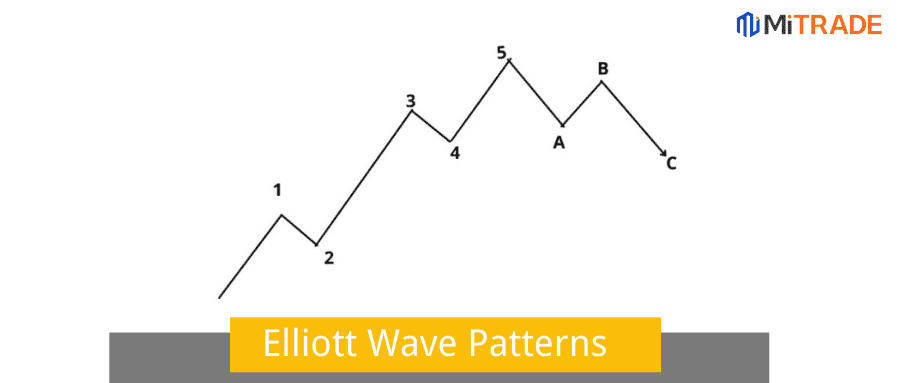How can you use Bollinger Bands in your strategies?
If you are just starting and want to learn the ropes of the market, then Bollinger Bands can be your choice.
The indicator is one of the most popular technical tools and is used by all levels of traders.
In this guide, we'll answer some of the key questions like
What are Bollinger Bands?
What are the common Bollinger Bands trading strategies?
Are there any limitations of the indicator?
So let's dive in and discover everything we can about the indicator
1. What are "Bollinger Bands"?
Developed by John Bollinger in the 1980s, Bollinger Bands (BB) tells about market volatility. The BB has three aspects: an upper and lower band and a middle line.
An upper band has two standard deviations above the moving average, and a lower band has two standard deviations below the moving average. The middle line is a 20-period simple moving average.
These bands expand and contract based on market volatility, with wider bands indicating higher volatility and narrower bands indicating lower volatility.
The BB tracks the volatility and price action of the asset over time, primarily used to identify price breakouts and to determine whether an asset is overbought or oversold.
In addition, it can also be used to identify bullish or bearish trend reversals and determine the strength of a trend.
Speaking of the trend, let's learn how to read Bollinger Bands.
2. Reading Bollinger Bands indicator
It can be daunting when you first apply the indicator as a beginner. However, reading BB isn't that difficult.
Here are a few steps you need to take:
Identify the trend
Start by identifying the direction of the trend. Look at the price action to determine whether it's trending up, down, or sideways.
Bollinger Bands work best when the market is trending, so it's important to identify the trend before analyzing the bands.
The above chart illustrates a downtrend. Notice how Bollinger Bands followed the price action
Observe the width of the bands
You can use the width of the band to gauge market volatility. If the bands are wider, it suggests high volatility, suggesting trend continuation.
Conversely, when the bands are narrow, it indicates lower volatility. This is known as a "Bollinger Bands squeeze" (more on that later) and often follows a significant price move.
Look for the overbought and oversold signals
When the price moves closer to the upper or lower band, it illustrates overbought and oversold levels.
When the price touches or crosses above the upper band, and lowers back toward the moving average line, it signifies an overbought level and that a price reversal or downtrend is imminent. Bulls are exhausted, and the bears can soon take over.
Conversely, when the price touches or crosses below the lower band, it highlights an oversold level. This suggests bears are getting exhausted, and we may have an upcoming bullish reversal or uptrend.
3. Key Points for making profits from Bollinger Bands
If you want to make some cool profits from Bollinger Bands, remember a few key points.
Bollinger Bands can help you identify price volatility. When the price is moving within the Bollinger Bands, it suggests that the asset is experiencing normal price volatility. When the price moves outside the bands, it indicates an increase in volatility.
When the price consistently moves in one direction and is outside the bands, it can indicate a strong trend. You can use this information to determine the direction of the trend and adjust your strategy accordingly.
Bollinger Bands makes finding entry and exit signals easier with trend-following and breakout strategies.
For example, in a trend-following strategy, you can enter that if the price stays further to the middle band, it’s likely to continue trending in the same direction. If the price did come closer to the middle band, you can exit the trade.
While Bollinger Bands can be useful, they are most effective when combined with other indicators to confirm signals and reduce the likelihood of false signals.
For instance, if the RSI is near the 70 (overbought level), and the price breaks above the upper band, it’s likely the trend will reverse.
4. How to Use Bollinger Bands? Strategies
Now that you know how to read the Bollinger Bands, let's move to how to use the indicator in your trading strategies.
There are multiple strategies you can use. Two of the most common are
Using Bollinger Bands in trend-following
Using Bollinger Bands to identify breakouts
Using Bollinger Bands to trade reversal
Using Bollinger Bands to find tops and bottoms
Trend-following strategy
The trend-following strategy follows the price action and doesn't look for the break above or below the upper/lower bands.
The first step in the trend-following strategy is to determine the trend direction using the Bollinger Bands.
When the price is trading above the middle band and the bands are widening, it may be a sign of an uptrend. When the price is trading below the middle band and the bands are widening, it may be a sign of a downtrend.
Once the trend has been identified, you can wait for a pullback toward the middle band before entering a trade.
In the chart below, you can see the price above the middle band, suggesting an uptrend.
Bollinger Bands trend-following strategy
Breakout strategy
The breakout strategy identifies breakouts above the upper band or below the lower band. It can signal a potential market reversal.
The first step in the Bollinger Band breakout strategy is to identify a market trading in a tight range. As mentioned earlier, this is also known as the squeeze.
You can easily find that out by analyzing if the bands' contract and the price move in a narrow range.
After that, you must wait for the price to break above or below the upper or lower Bollinger Band. This breakout indicates overbought and oversold levels.
Bollinger Bands squeeze
On the chart above, you can see the price traded in a tight range, and once the price breaks above the upper band, we see a bearish reversal.
Pro Tip: To confirm the breakouts or trend continuation, you can use other technical indicators, such as the Moving Average Convergence Divergence (MACD) or Relative Strength Index (RSI), along with the Bollinger Bands. These indicators can provide additional insight into the trend's strength and whether it is likely to continue.
Reversal strategy
Bollinger bands can be used as a mean reversion strategy. It assumes that whenever the price moves away from the median, it is attracted back to it. The median line acts as a magnet. Let’s take a look at the chart below to understand this further.
The arrows show reversal points. The price hit the outer bands and then quickly reversed toward the median. This can be a great opportunity for traders. They can catch reversals and profit from the price movement. Let’s dig it out with the help of an example.
Here’s an example of GBPUSD chart. The price hits the lower band and starts reversing. Wait for the bullish candle to close to enter. You can exit the position in profit when the price hits the median line. You can exit in loss when the price exceeds the low of the entry candle.
Finding tops and bottoms
Bollinger Bands can be used to identify potential W bottoms and M tops in a price chart. W bottoms and M tops are reversal patterns that tell about key market reversals.
The W bottom contains two lows, occurs in a downtrend, and signals a bullish reversal.
To confirm a W bottom with Bollinger Bands, follow these four steps.
The price reaches a low point, forming the first trough of the W pattern. This low is generally lower than the lower band. Then the price rebounds from the low point and reaches a high point, forming the first peak of the W pattern.
After that, the price pulls back from the first peak and forms a second trough higher than the first trough.
Then, the price rebounds from the second trough and reaches a second peak that is higher than the first peak.
The price pulls back from the second peak and approaches the middle band of the Bollinger Bands. The price breaks above the middle band, indicating a potential bullish reversal.
The M top has two top forms in an uptrend and suggests a bearish reversal.
To confirm the M top with Bollinger Bands, follow these steps:
The price reaches a high point, forming the first peak of the M pattern. Then, the price pulls back from the first peak and reaches a low point, forming the first trough of the M pattern.
After that, the price rebounds from the first trough and reaches a second peak that is lower than the first peak.
Then, the price pulls back from the second peak and forms a lower trough than the first trough.
The price rebounds from the second trough and approaches the middle band of the Bollinger Bands. The price breaks below the middle band, indicating a potential bearish reversal.
5. When Should You Use
Part of the breakout and trend-following strategy is when to enter or exit the trade. This section will identify when to use Bollinger Bands for bullish and bearish signals.
Let's start with signals for the trend-following strategy.
Bullish signal
A bullish trend is indicated when the price moves above the middle Bollinger Band and stays above it. It indicates that the price is trending higher and is likely to continue.
You can enter a long position when the price exceeds the middle band. You can set a stop loss order below the lower Bollinger Band and exit the trade when the price breaks above the upper band.
Bollinger Bands trend-following bullish signal
Bearish signal
You can find the bearish signal when the price moves below the middle band and stays below it. It indicates the price is trending lower and is likely to continue.
You can enter a short position when the price crosses below the middle Bollinger Band, set a stop loss order above the upper Bollinger Band, and exit the trade when the price touches the lower band.
Bollinger Bands trend-following bearish signal
Now let's head to the Bollinger Bands breakout strategy bullish and bearish signals.
Bullish signal
When the price breaks below the lower band, you can look for a long entry point.
Although you can enter once the price breaks below the lower band, it’s best to wait for the price to move toward the middle band and then enter. This is because sometimes the price can reverse back to the lower band.
It's important to wait for the price to continue moving upwards and then enter, as the price can reverse.
Place a stop-loss below the lower band, and exit the trade when the price touches or breaks above the upper band.
Bollinger Bands breakout bullish signal
Bearish signal
When the price breaks above the upper band, it signals a bearish reversal. Although you can enter once the price breaks above the upper band, it’s best to wait for the price to move toward the middle band and then enter. This is because sometimes the price can reverse back to the upper band.
Wait for the price to continue downwards, as it may reverse. Place a stop-loss above the upper band and exit the trade when the price touches or breaks below the lower band.
6. Disadvantages and limitations
Bollinger Bands is not a fool-proof indicator. It has its fair share of limitations you should be aware of before applying them to your trading strategies.
Bollinger Bands are prone to generating false signals, particularly during periods of low volatility. That's why you should exercise caution when relying solely on Bollinger Bands to make trading decisions. You should consider using other technical indicators or fundamental analyses to confirm the signals.
Bollinger Bands are a lagging indicator, meaning that they are based on past price data and do not provide real-time information. In this way, you may miss out on potential trading opportunities.
Bollinger Bands are based on the assumption that price volatility is a reliable indicator of potential price movements. However, there may be instances where volatility does not accurately reflect price movements, leading to inaccurate trading signals.
All Markets: Bollinger Bands may not be suitable for all markets and asset classes. For example, they may not be effective in markets with low volatility.
Conclusion
Bollinger Bands are a useful technical analysis tool that can help you identify potential trends, reversal patterns, and measure volatility.
By combining Bollinger Bands with other technical analysis tools and market indicators, you can gain a deeper understanding of market trends and make more informed trading decisions.
* The content presented above, whether from a third party or not, is considered as general advice only. This article should not be construed as containing investment advice, investment recommendations, an offer of or solicitation for any transactions in financial instruments.
- Original
- Trading Analysis

Risk Warning: Trading may result in the loss of your entire capital. Trading OTC derivatives may not be suitable for everyone. Please consider our legal disclosure documents before using our services and ensure that you understand the risks involved. You do not own or have any interest in the underlying assets.


.jpg)
.png)

